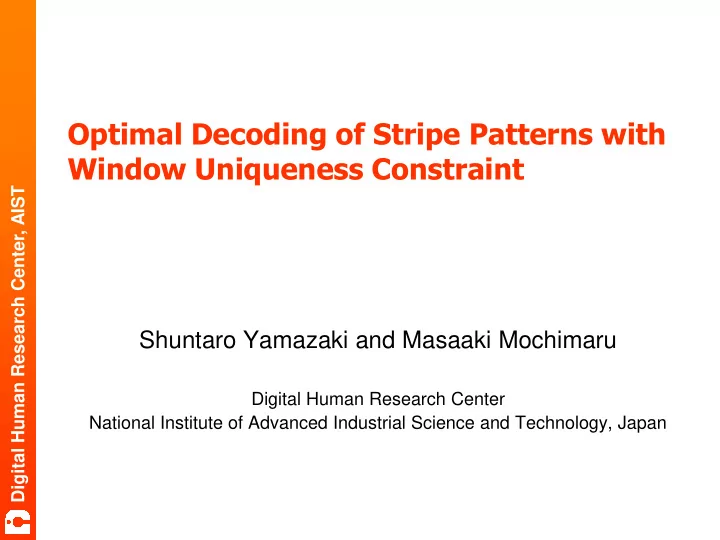

Optimal Decoding of Stripe Patterns with Window Uniqueness Constraint Digital Human Research Center, AIST Shuntaro Yamazaki and Masaaki Mochimaru Digital Human Research Center National Institute of Advanced Industrial Science and Technology, Japan
One-shot depth acquisition Structured Light for Moving Objects Digital Human Research Center, AIST
Spatially-Coded Illumination 1D Discrete Continuous – De Bruijn sequence – Phase-shifting [Hugli 1989] [Zhang 2002] [Wust 1991] Digital Human Research Center, AIST [Lim 2009] [Yamazaki 2011] [Guan 2004] – Frequency-multiplexing Dense & Robust [Takeda 1983] [Gdeisat 2006] [Berryman 2008] [Zhang 2008] [Wu 2006] [Cobelli 2009] 2D Discrete – M-array [Griffin 1992] [Morano 1998] [Pages 2006] [Kinect] – Spatial multiplexing [Carrihill 1985] [Tajima 1990] – Non-formal [Maruyama 1995] [Forster 2007] [Sagawa 2012] [Kawasaki 2008] Very Robust Subpixel Sparse Sensitive Taxonomy by [Salvi 2010]
De Bruijn Color Code De Bruijn sequence B( k , n ) – Cyclic sequence – Composed of symbols with size k Digital Human Research Center, AIST – Unique subsequence of length n B(5,3 )={…, 2,0,0,3,0,0,4,0,1,1,0,1,2,0,1,3,0,1,4,0,2 ,…} Window Uniqueness Property Color Stripes – Direct [Hugli 1989] – XOR [Zhang 2002] – Non-recurring [Lim 2009] – Hamming [Yamazaki 2011]
Decoding Structured Light Window Uniqueness Digital Human Research Center, AIST
Decoding Structured Light ? 1D pattern matching Digital Human Research Center, AIST • Smoothness constraint • Window uniqueness constraint • Monotonicity constraint
Decoding Structured Light Global optimization – Annealing, Graph-cut, Belief propagation, etc. – High computational cost – Digital Human Research Center, AIST Convergence not guaranteed Greedy search – propagates local reconstruction [Forster 2006] – sometimes yields better results than the global methods [Schmalz 2010] – 10+ FPS by CPU implementation Dynamic Programming Matching (DPM) m – Optimal, pseudo linear algorithm : O(whm) – Monotonicity assumption w Multipass DP [Zhang 2002] : O(whm) Non-monotonic DP [Mei 2011] : O(w hm) 2 h – 60+ FPS by GPU implementation [Yamazaki 2011]
Digital Human Research Center, AIST Dynamic Programming
Dynamic Programming pattern coordinate pattern skip Digital Human Research Center, AIST Image scanline coordinate match non-feature match occlusion occlusion Monotonicity assumption No monotonicity assumption [Zhang 2002] [Mei 2011]
Backtracking Spurious matching pattern coordinate Digital Human Research Center, AIST Image scanline coordinate No window uniqueness constraint
Proposed DPM pattern coordinate Inner DPM Outer DPM Digital Human Research Center, AIST Image scanline coordinate non-feature non-feature match consecutive match occlusion occlusion n Monotonicity assumption No monotonicity assumption + window uniqueness constraint [Zhang 2002] [Proposed]
Computational Complexity For each scanline : h • Generate DPM table T : O(wm) • For each column r in T : m Digital Human Research Center, AIST • Solve Inner DPM : O(w) O(whm) • For each row r in c : w • Find the optimal solution : O(1) • Backtrack : O(w) m w m h w Same complexity as conventional DPM
Experiments Color Stripes based on De Bruijn sequences (n=4) – Direct [Hugli 1989] {1, …, 7} = {001, …, 111} = {red, …, white} Digital Human Research Center, AIST Black separators inserted – XOR [Zhang 2002] {1, …, 7} = { ⊕ 001, …, ⊕ 111} Encoded into stripe borders – Non-recurring [Lim 2009] Eliminated consecutive symbols from a De Bruijn sequence – Hamming [Yamazaki 2011] Eliminated simultaneous bit flips from a De Bruijn sequence
Result - Direct Digital Human Research Center, AIST Conventional DPM Proposed
Result - XOR Digital Human Research Center, AIST Conventional DPM Proposed
Result – Non-recurring Digital Human Research Center, AIST Conventional DPM Proposed
Result – Hamming Digital Human Research Center, AIST Conventional DPM Proposed
Timing CPU: Intel Core i7 X940 2.13GHz Input: – Image width : w = 640 ~ 2048 – Image height : h = 480 Digital Human Research Center, AIST – Code length : m = 110 – Window uniqueness : n = 4 sec sec pixel pixel Monotonicity assumption : O(whm) No monotonicity assumption : O(w hm) 2
Discussion Significant improvement on depth boundaries. The boundaries are always unreliable in the conventional DPM. 2 ~ 3 time longer computation time Digital Human Research Center, AIST Additional data structure is required for the path of consecutive matches. GPU-implementation for real-time reconstruction Subtle improvement ? Conventional DPM is tuned for fair comparison. Penalty for pattern break Range of stripe interval Streaking artifacts Fundamental limitation of scanline-based algorithm Considering inter-scanline consistency Quantitative comparison missing
Conclusion Two-level Dynamic Programming Matching – Optimal decoding of color stripes – Window uniqueness constraint – Digital Human Research Center, AIST Same complexity as conventional methods : O(whm) Applicable to several systems – Independent of color stripes – Demonstration using 4 different patterns – Achieved better results with little additional cost Optimal v.s. Sub-optimal – Combination with sub-optimal algorithms for inter-scanline consistency Practical issues – Constant factors matter – Efficient implementation required
Recommend
More recommend